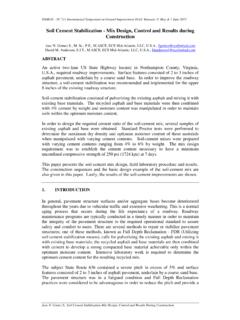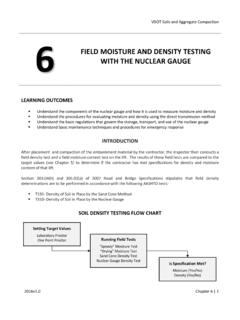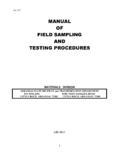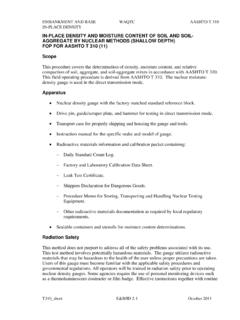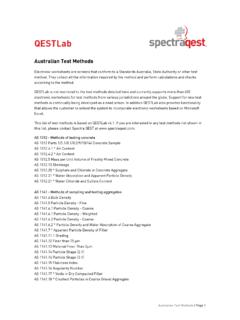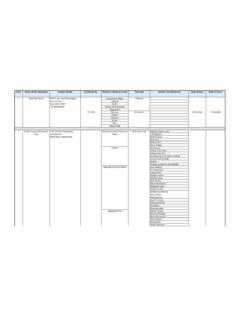Transcription of Soil Cement Stabilization - Mix Design, Control and ...
1 ISSMGE - TC 211 International Symposium on Ground Improvement IS-GI Brussels 31 May & 1 June 2012. soil Cement Stabilization - Mix design , Control and Results during Construction Jose N. Gomez S., M. Sc., , , ECS Mid-Atlantic, LLC, , David M. Anderson, , , ECS Mid-Atlantic, LLC, , ABSTRACT. An active two-lane US State Highway located in Northampton County, Virginia, , required roadway improvements. Surface features consisted of 2 to 3 inches of asphalt pavement, underlain by a coarse sand base. In order to improve the roadway structure, a soil - Cement Stabilization was recommended and implemented for the upper 8 inches of the existing roadway structure. soil - Cement Stabilization consisted of pulverizing the existing asphalt and mixing it with existing base materials. The recycled asphalt and base materials were then combined with 4% Cement by weight and moisture content was manipulated in order to maintain soils within the optimum moisture content.
2 In order to design the required Cement ratio of the soil - Cement mix, several samples of existing asphalt and base were obtained. Standard Proctor tests were performed to determine the maximum dry density and optimum moisture content of these materials when manipulated with varying Cement contents. soil - Cement mixes were prepared with varying Cement contents ranging from 4% to 6% by weight. The mix design requirement was to establish the Cement content necessary to have a minimum unconfined compressive strength of 250 psi (1724 kpa) at 7 days. This paper presents the soil - Cement mix design , field-laboratory procedure and results. The construction sequences and the basic design example of the soil - Cement mix are also given in this paper. Lastly, the results of the soil - Cement improvements are shown. 1. INTRODUCTION. In general, pavement structure surfaces and/or aggregate bases become deteriorated throughout the years due to vehicular traffic and extensive weathering.
3 This is a normal aging process that occurs during the life expectancy of a roadway. Roadway maintenance programs are typically conducted in a timely manner in order to maintain the integrity of the pavement structure to the required operational standard to assure safety and comfort to users. There are several methods to repair or stabilize pavement structures; one of these methods, known as Full Depth Reclamation - FDR (Utilizing soil Cement Stabilization means), calls for pulverizing the existing asphalt and mixing it with existing base materials; the recycled asphalt and base materials are then combined with Cement to develop a strong compacted base material achievable only within the optimum moisture content. Intensive laboratory work is required to determine the optimum Cement content for the resulting recycled mix. The subject State Route 636 contained a severe pitch in excess of 5% and surface features consisted of 2 to 3 inches of asphalt pavement, underlain by a coarse sand base.
4 The pavement structure was in a fatigued condition and Full Depth Reclamation practices were considered to be advantageous in order to reduce the pitch and provide a Jose N. Gomez S., soil Cement Stabilization -Mix design , Control and Results During Construction. ISSMGE - TC 211 International Symposium on Ground Improvement IS-GI Brussels 31 May & 1 June 2012. suitable base for the proposed roadway and at the same time improve the pitch of the existing roadway. A total of eight (8) sample locations were selected for exploration at intervals no greater than 1,320 feet according to the Virginia Department of Transportation (VDOT). requirements. Asphalt and base materials were removed, pulverized and mixed to a maximum depth of 8 inches below the top of pavement. All samples were subject to extensive, laboratory controlled testing and all data was recorded and analyzed according to VDOT and ASTM standards. The mix design requirement was to establish the Cement content necessary to have a minimum unconfined compressive strength of 250 psi (1724 kpa) at 7 days.
5 According to the research, it was found that a Cement content of 4% Cement by weight was acceptable for the blend of pulverized asphalt and existing base materials. This paper contains the interpretation and results of our field exploration and soil Cement mix design for Route 636 reclamation, located on Cobbs Station Road in Northampton County, Virginia, The owner of the project is VDOT, Hampton Roads District; the reclamation project was conducted by Slurry Pavers Incorporated and the design and field quality Control (QC) were performed by ECS Mid-Atlantic, LLC (ECS). The authors of this paper would like to thank Michael J. Galli of ECS for providing input and review of this paper. Works were carried out during the summer of 2010. 2. PROJECT CHARACTERISTICS. The subject roadway reclamation project is located along State Route 636 Cobbs Station Road in Northampton County, Virginia, The project is located in what is called the Easternshore at the Mid-Atlantic portion of the country (coastal region).
6 The roadway reclamation project consisted of the widening of the existing roadway along a length of approximately 5,000 feet (1,524 meters), and stabilizing the existing pavement cover and base by means of soil Cement Stabilization . The total thickness of the stabilized portion was approximately 8 inches ( meters). In order to accomplish soil - Cement Stabilization using the FDR technique, the existing asphalt was pulverized and mixed with existing base materials. The recycled asphalt and base materials are then combined with a specified amount of Portland Cement and the moisture content is manipulated in the field in order to maintain the soils at levels of optimum moisture content as determined in the soils laboratory by means of the Standard Proctor test. The soil Cement material (or reclaimed material) is then roller compacted in one lift of approximately 8 inches with Cement , moisture, and aggregate blended at specified levels required to achieve the minimum compressive strength.
7 3. EXPLORATION PLAN AND RESULTS. Site Conditions At the time of the subsurface investigation and design analysis, the existing roadway was active and located within a coastal region; the ground water table was within 2 to 3. feet below the ground surface. The roadway is paralleled by drainage ditches and is surrounded by agricultural facilities. Jose N. Gomez S., soil Cement Stabilization -Mix design , Control and Results During Construction. ISSMGE - TC 211 International Symposium on Ground Improvement IS-GI Brussels 31 May & 1 June 2012. Photo 1 and 2 depict project site before starting the reclamation works. Photo 1 Photo 2. Existing Pavement Structure Conditions It was observed that the existing roadway consists of 2 to 3 inches of asphalt pavement. Approximately 6 to 8 inches of coarse sand fill material was encountered underlying the asphalt pavement. Laboratory testing determined the actual field moisture content with the added asphalt material is approximately 4%.
8 The underlying coarse sand fill appeared to be well graded and consistent throughout the existing roadway. The existing roadway had an approximate pitch of 5% and the reclamation process is intended to aid in reducing the existing pitch and fatigued pavement structure. The reclamation process was anticipated to include only the asphalt pavement and base materials; no subgrade soils were anticipated to be included within the mix design . Samplings of the road base are depicted within Photos 3 and 4. Photo 3 Photo 4. 4. soil Cement MIX design . Method Description soil samples were extracted from the existing roadway at intervals no greater than 1,320. linear feet (402 meters) within each lane. Sample extraction was controlled in order to ensure the proper depth and ratio of pavement to base soils was consistent with anticipated construction procedures. Bulk samples and asphalt pavements were pulverized and blended within the laboratory using mechanical means to gradations similar to typical blending of the field equipment.
9 Jose N. Gomez S., soil Cement Stabilization -Mix design , Control and Results During Construction. ISSMGE - TC 211 International Symposium on Ground Improvement IS-GI Brussels 31 May & 1 June 2012. Laboratory testing consisted of full gradation analysis, Standard Proctor testing, molding of cylinders for compressive strength testing; compacted to 97% maximum dry density having Cement contents of 4%, 5%, and 6%. Average maximum dry density and optimum moisture content were within 127 pcf and , respectively. Density results are depicted within Figure 1. Dry Density 130 (pcf). Dry Density (pcf). Zero Air Voids Curve 129 Zero Air Voids Curve 128. Gs = Gs = 127. 126. 125. 124. 123. 122. 121. 120. 118 119. 116 117. 114 115. 0 2 4 6 8 10 12 14 2 3 4 5 6 7 8 9 10 11 12. Moisture Content (%) Moisture Content (%). Dry Density (pcf) Dry Density (pcf). 129 Zero Air Voids Curve 129 Zero Air Voids Curve Gs = Gs = 127 127. 125 125. 123 123.
10 121 121. 119 119. 117 117. 115 115. 2 3 4 5 6 7 8 9 10 11 12 2 3 4 5 6 7 8 9 10 11 12. Moisture Content (%) Moisture Content (%). Figure 1. Unconfined Compressive Strength Results A total of 24 cylinder samples were formed using differing Cement contents of 4%, 5%. and 6% by weight. Samples were prepared to 97% maximum dry density using Standard Proctor compaction test procedures. Average compressive strengths for soil Cement cylinders made from the blended base material with Cement contents of 4%, 5% and 6% were psi, psi and psi, respectively. As indicated within Figure 2, soil Cement strengths increase progressively as Cement content increases. Compressive strength increased in average by approximately 18% from 4% to 5% Cement content, and 27% increase from 4% to 6% Cement content. soil Cement cylinders made from samples 1 through 8, taken on the existing roadway, were tested at 7 days and compressive strengths greater than 250 psi were observed for all samples tested.
